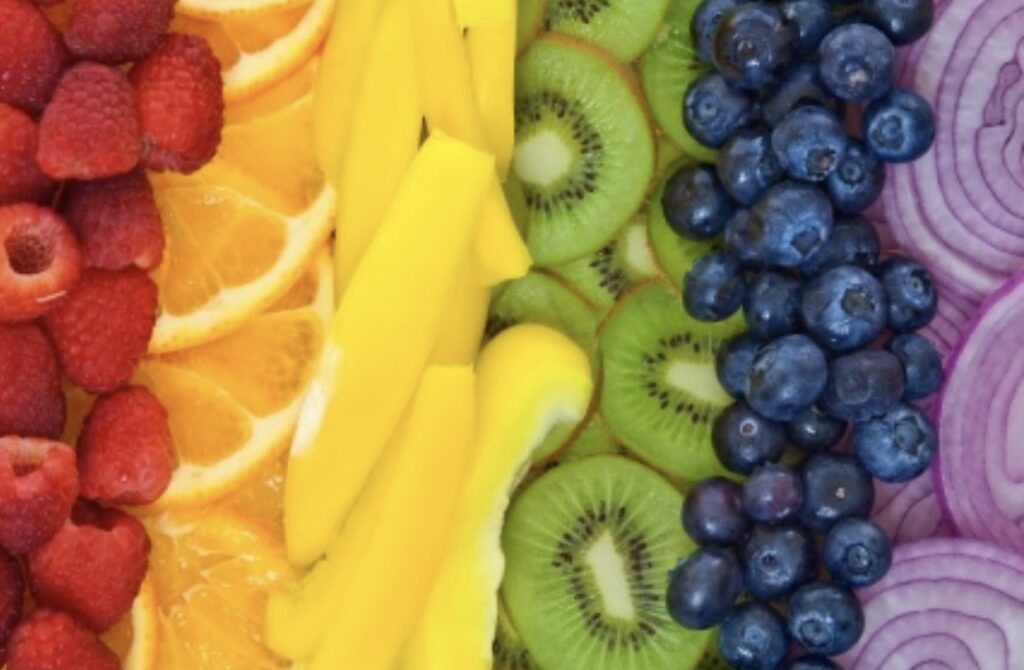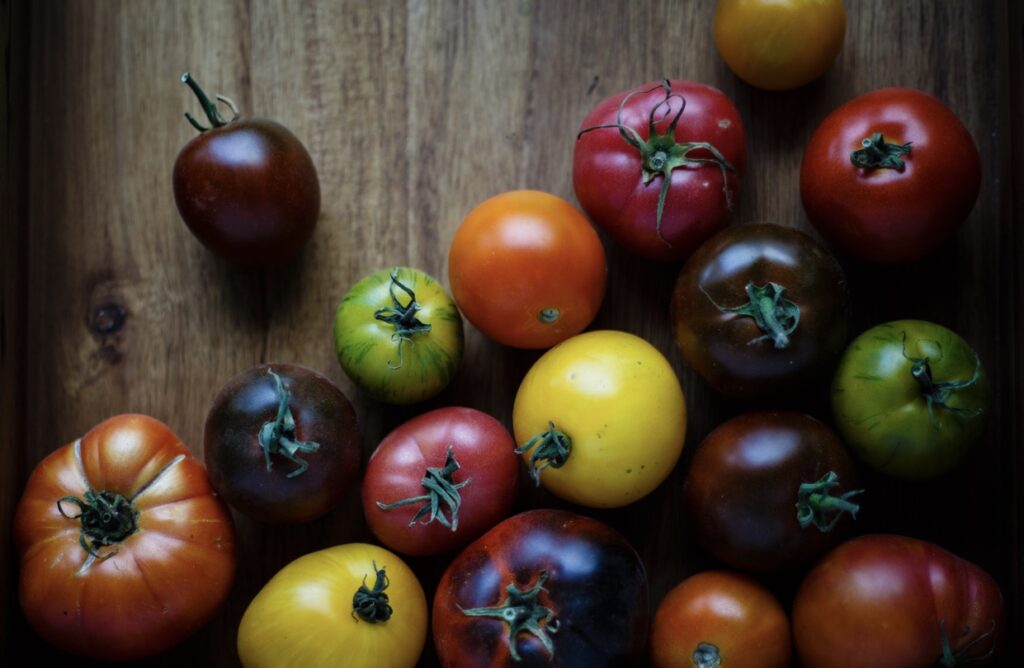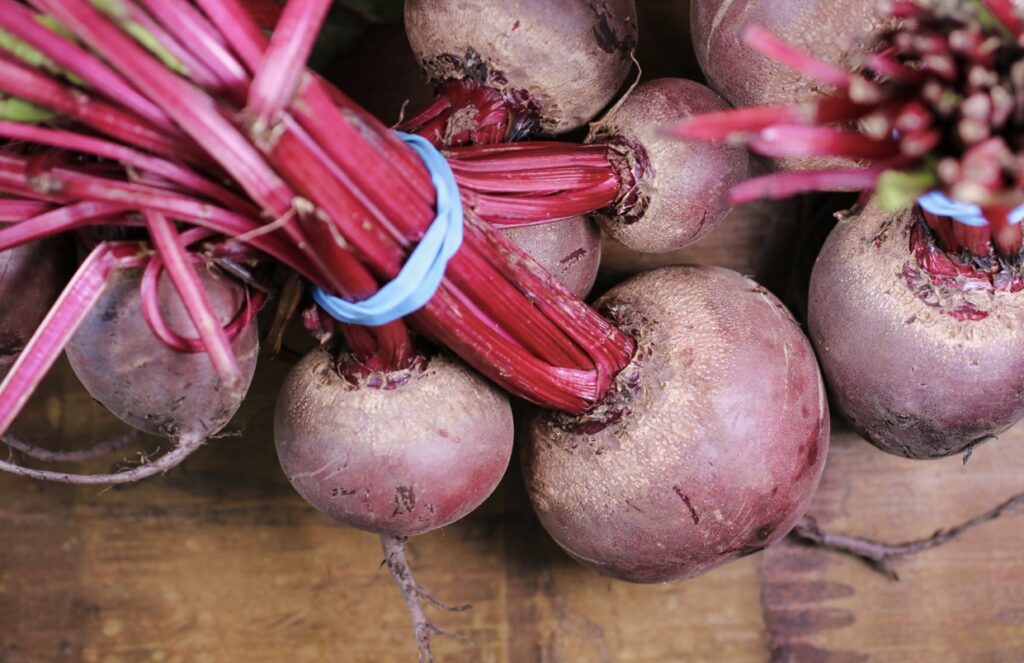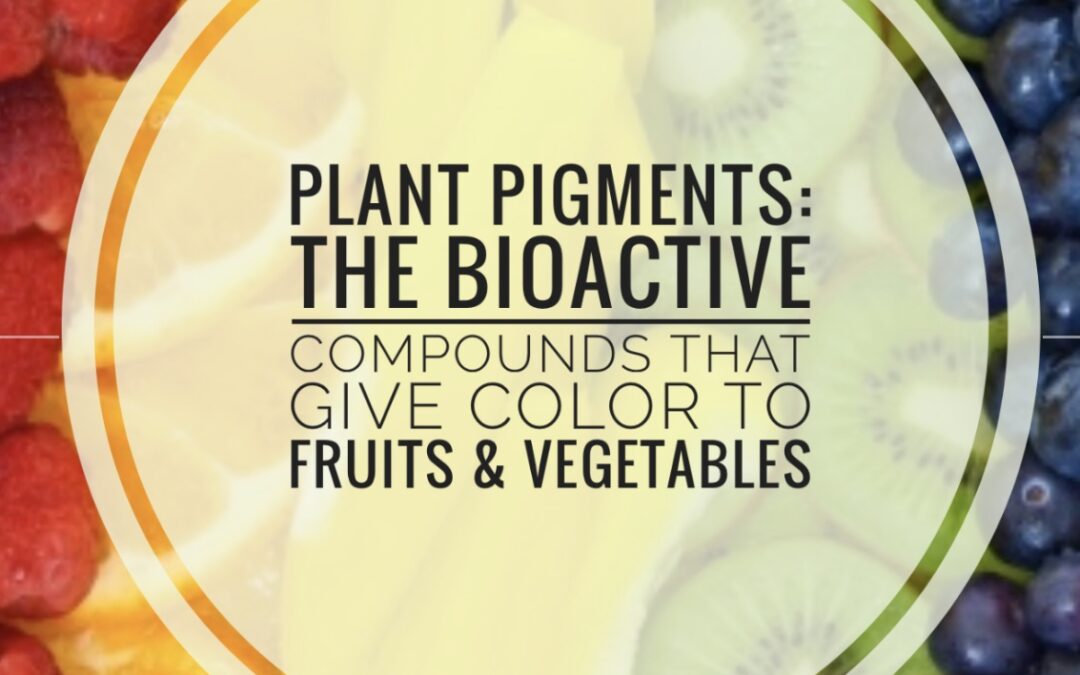The four major plant pigments that give fruits and vegetables their beautiful colors have more to offer than just vitamins and minerals – they offer potential health benefits, including protection against disease and disease processes.

It’s August. I don’t know about you all, but I feel like the past few months flew bye.
With the fall season quickly approaching, it’s time to focus your attention your health, and how you can support it with good nutrition. One simple way to boost your nutrient intake, is to eat more colorful fruits and vegetables.
Everyone Agrees – Americans Need To Eat More Fruits And Vegetables
It’s no secret that fruits and vegetables are healthy. They’re the one group of food that government agencies, environmental groups and health experts all agree deserve a place on your plate. There’s loads of evidence to prove it, too. Study after study shows that eating more produce can improve your health and help prevent diseases.
Despite what we know, only 1 in 10 Americans eat enough fruits and vegetables in a day. I’ve shared that statistic before, and I’m sure I’ll share it again. I hope that one day, that statistic will change for the better. Honestly, it can’t get much worse.
The Benefits Of Fruits & Vegetables – Beyond Vitamins & Minerals
So, why aren’t people eating enough fruits and vegetables? While there are many reasons, one that I hear often is that a multivitamin and mineral supplement will make up for a diet low in fruits and vegetables. I agree, taking vitamin and mineral supplements can help fill the gaps in your nutrients. But fruits and vegetables have more to offer than common nutrients. They have other beneficial compounds that support your health. Compounds you won’t find in your multivitamin.
I’m talking about plant pigments – the substances in plants responsible for the beautiful natural colors of produce. Some of those pigments are sold in supplement form, but the best, and safest way to get them is through food.
What Are Plant Pigments And Why Are They Important?
Plant pigments is a generic term used to designate a large number of colored molecules. Those molecules give color to plant foods, like fruits and vegetables, as well as living plants, like flowers and leaves.
Plant pigments play an important role in plant metabolism, and they’re also important for humans. The color of a food can influence your perception of the food, and your desire to eat it. Some of those perceptions are innate, while others are learned from experience and education. Though not always the case, the vibrant colors that plant pigments produce signifies freshness, nutritional value, safety, and value.
Aside from perception, plant pigments also suggest potential health benefits, including protection against disease and disease processes.
What Are The Four Major Plant Pigments?
There are four major categories of plant pigments that give color to foods. They are:
- Carotenoids (Yellow, Orange, Red)
- Anthocyanins (Red, Blue, Purple)
- Chlorophylls (Green)
- Betalains (Red)
Each pigment category has a family of compounds within them, each with a unique name, chemical structure, chemical properties and unique color. Incorporating a variety of fruits and vegetables from each group, into your meal plan, is a great way to boost your nutrient intake, and support your health.
I could write an entire post on each of the major plant pigments. For this post, however, I’m sharing what they are, what foods contain them and why you should eat more of them.
What Are Carotenoids?
The first plant pigment I want to talk about is carotenoids. They are responsible for the colors yellow, orange and red, and are also found in some green vegetables. A few animal-derived foods contain carotenoids, too.
When it comes to potential health benefits, carotenoids are the most studied plant pigment. They’re most known for their provitamin A activity, which is important for eye health and reducing the risk of macular degeneration. But, they are studied for many other potential health-promoting effects too. They are thought to support immune health and may play a role in reducing the risk of developing chronic diseases like cancer and cardiovascular disease. It’s their bioactive compounds and antioxidant activity thought to be responsible for their potential health benefits.
There are over 600 carotenoids in nature. The most common ones in foods, however, are beta-carotene, alpha-carotene, beta-cryptoxanthin, lycopene, lutein and zeaxanthin.
What Foods Are Rich In Carotenoids?
You can find the different carotenoids in a wide range of of fruits and vegetables. The main sources of lutein are green vegetables, including spinach and kale, egg yolks, parsley and basil. Corn and corn products – especially tortilla and corn chips – are major sources of both lutein and zeaxanthin in the diet.
When it comes to lycopene-rich foods, tomatoes and tomato products, red-fleshed papaya, watermelon and pink-fleshed guava are the most common. Beta-cryptoxanthin is the carotenoid is responsible for the orange color of butternut squash, hot chili peppers, tangerines, oranges, papaya, persimmon and sweet red peppers, among others.
Of the common carotenoids, beta-carotene seems to be the most familiar. Rich sources include some palm fruits, some varieties of squash, green vegetabls, green-leafy vegetables, carrots, the flesh of sweet potatoes, cantaloupe, mango and apricot. Carrots, and some varieties of squash, pumpkin and palm fruits contain both Beta-carotene and alpha-carotene. Those two carotenoids are often found together in foods.
What Are Anthocyanins?
Anthocyanins give fruits and vegetables (and flowers) their vibrant blue, purple and red colors. They belong to a family of compounds known as flavonoids. More than 500 different anthocyanins have been identified, with cyanidin being the most common.
Like carotenoids, numerus studies have examined the biological activities and potential health-promoting effects of anthocyanins. Most, though, have been done using animal models or in vitro cell studies. While those studies show promise, research on humans, showing similar results, will need completed before we can say for sure. Either way, it won’t hurt you to load up on these plant-pigments. The human studies that we do have support their potential health promoting benefits. And, they are packed with vitamins, minerals and fiber to support your health.
What Foods Are Rich In Anthocyanins?
Anthocyanins are found in a wide variety of plant foods, including fruits, vegetables, wine, grains, nuts, roots and flowers. Major dietary sources include purple grapes, cherries, cranberries, pomegranate, red cabbage and black currant. They’re also the pigment in my favorite fruit – berries. Raspberries, blackberries, blueberries,and strawberries are all rich in anthocyanins.
Other foods rich in anthocyanins are black carrots, purple corn, black rice, hazelnuts, pecans, chickpeas and eggplant. By incorporating a few of these foods into your weekly meal plan, you can increase your intake of this plant pigment.
What Are Chlorophylls?
Chlorophyll’s represent the green pigments found in plants. They are porphyrins, and are sometimes referred to tetrapyrroles. That name represents a pigment with a specific chemical structure. Chlorophyll A and B are the common green pigments found in lettuce leaves and other green leafy vegetables. They are also present in different varieties of tree tomato fruits. Chlorophyll A represents a blue-green color, while chlorophyll B is more of a yellow-green color.
Like all plant pigments, the color of chlorophyll is affected by a variety of factors, such as aging, enzymes, weak acids, heat, oxygen and light. That’s why you’ll see different shades of green even within the same vegetable. A good example of that is comparing canned vegetables to frozen varieties. Canned are generally lighter in color, due to the formation of pheophytin during thermal treating. Efforts are in place to maintain the green color as much as possible, and minimize the loss of chlorophyll.
Studies on the health benefits of chlorophylls are very limited. However, many vegetables are known to contain more than just one plant pigment.

What Foods Are Rich In Chlorophylls?
Chlorophylls are the primary pigment in green leafy vegetables. Lettuce leaves, Brussels Sprouts, edible seaweed and green leafy vegetables specific to the Mediterranean region are among the vegetables with the highest concentration of chlorophylls. Romaine, Broccoli, spinach and types of tree tomato fruits all rich in chlorophylls.
Many vegetables that contain chlorophylls also contain carotenoids. That’s why, if you eat a variety of fruits and vegetables, you’ll likely be adding a variety of different plant pigments.
What Are Betalains?
Betalains are water soluble pigments consisting of two groups – the red to violet colored betacyanin’s and the yellow, orangish colored betaxanthins.
Research on the potential health benefits of betalains is in the early stages and is inconclusive. One study did show a benefits on atherosclerotic risk factors in coronary artery disease patients. The study concluded that food sources of betalains improved the lipid profile and levels of homocysteine, glucose, blood pressure. It even showed improved quality of life, in some patients. Beet root, specifically, has been studied for its antioxidant activity and its potential to lower blood pressure. The benefit on blood pressure, however, appears to be due to the presence of dietary nitrate, rather than the pigment betanin.

What Foods Are Rich In Betalains?
Of the major plant pigments, betalains are the least present one found in common fruits and vegetables. Edible food sources consist primarily of red beet roots and prickly pears. Edible amaranth, though not common, is also a rich source of betalain.
Bottomline
Colorful fruits and vegetables contain one or more plant pigments and are packed with vitamins, minerals and phytonutrients. Together, these nutrients and compounds work to support health and slow the development of chronic diseases. The next time you go shopping for produce, try loading your cart with a variety of colors. With so many to choose from, it’s not hard to do. Then, incorporate 5-9 servings into your daily meal plan.


 Hi, I’m Heather – a registered dietitian, busy mom, consultant, adventure junkie and travel addict who has mastered living healthy on the go. My blog is where I share simple recipes and healthy living tips to help and inspire others to live their best life.
Hi, I’m Heather – a registered dietitian, busy mom, consultant, adventure junkie and travel addict who has mastered living healthy on the go. My blog is where I share simple recipes and healthy living tips to help and inspire others to live their best life.
Trackbacks/Pingbacks